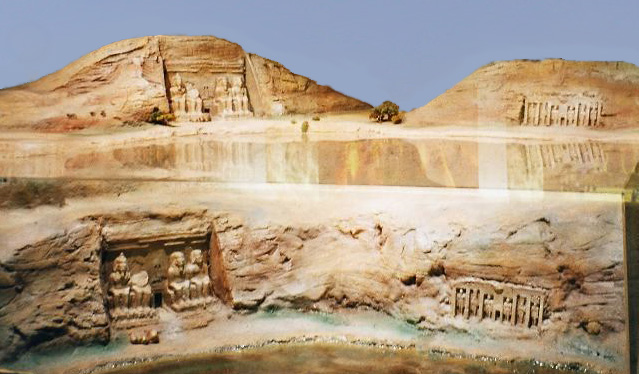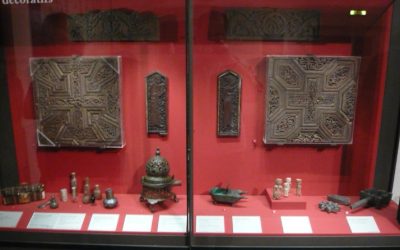Historical Significance of Abu Simbel
Abu Simbel holds a profound historical significance as one of Egypt’s most remarkable ancient monuments. Carved out of solid sandstone cliffs, this archaeological site features colossal temples built during the reign of Pharaoh Ramses II around 1264 BC. It not only exemplifies the architectural prowess of Ancient Egypt but also symbolizes the divine authority and military strength of Ramses II. Over the centuries, Abu Simbel has become a symbol of Egypt’s rich cultural heritage and a testament to the ingenuity of ancient engineering and artistry.
Construction and Pharaoh Ramesses II
Abu Simbel holds immense historical significance as one of Egypt’s most iconic monuments, symbolizing the grandeur of ancient Egyptian civilization. Carved into the cliffs of southern Egypt during the reign of Pharaoh Ramesses II, it reflects the political and religious power of the dynasty and serves as a testament to the advanced engineering skills of the ancient Egyptians. The site was strategically built to honor the gods and commemorate Ramesses II’s victorious reign, ensuring his legacy endured through centuries.
The construction of Abu Simbel was a monumental undertaking, involving precise planning and masterful craftsmanship. The temple complex consists of massive rock-cut statues of Ramesses II, which guard the entrance and demonstrate the pharaoh’s divine status. The temples were carved out of solid sandstone bedrock, a process requiring sophisticated tools and techniques, some of which remain a marvel for archaeologists today. The relocation of Abu Simbel in the 1960s, due to the construction of the Aswan High Dam, underscores its importance and the modern efforts to preserve ancient heritage.
Pharaoh Ramesses II, known as Ramesses the Great, played a pivotal role in Egyptian history as one of its most powerful and influential rulers. His reign, which lasted for over 60 years during the 13th century BCE, was marked by military campaigns, extensive building projects, and the expansion of Egypt’s borders. Abu Simbel stands as a lasting symbol of his authority and divine right to rule, reflecting his desire to impress his subjects and intimidate rivals while also ensuring his spiritual protection among the gods. The impressive scale and artistry of Abu Simbel exemplify the grandeur and legacy of Ramesses II’s reign.
Strategic Location Along the Nile
Abu Simbel holds immense historical significance as an enduring symbol of ancient Egyptian civilization and their architectural prowess. The site is renowned for its massive rock-cut temples built during the reign of Pharaoh Ramses II in the 13th century BCE, showcasing the power and divinity of the pharaoh while also serving as a tribute to the gods.
Furthermore, Abu Simbel’s strategic location along the Nile River played a crucial role in its historical importance. Positioned near the southern border of Egypt, it served as a monumental marker of Egyptian territory and influence in Nubia, helping to assert control and facilitate communication along the vital waterway.
- Acted as a political and religious center that reinforced Egyptian dominance in Nubia.
- Served as a testament to Egyptian engineering and artistic achievement.
- Functioned as a guide for travelers and caravans navigating the Nile region.
- Symbolized the merging of military strategy and spiritual devotion in ancient Egypt.
Religious Importance and Dedication to Gods
Abu Simbel holds immense historical significance as an architectural masterpiece of ancient Egypt, showcasing the technical prowess and artistic achievement of the New Kingdom period. Built during the reign of Pharaoh Ramses II around 1264 BCE, it demonstrates the era’s advanced construction techniques and symbolizes the power and stability of Egypt during this time.
The religious importance of Abu Simbel is evident through its function as a monumental temple dedicated to the gods Amun, Ra-Horakhty, and Ptah, as well as to Ramses II himself. The site served both as a place of worship and as a way to reinforce the divine status of the pharaoh, blending religious devotion with political authority.
The temple complex is specifically designed as a dedication to gods, emphasizing the divine rule of Ramses II and his association with the gods. The grand statues of Ramses II at the entrance symbolize his divine nature and eternal rule, while the interior chambers and hieroglyphic inscriptions narrate myths and religious doctrines, highlighting Egypt’s spiritual beliefs and reverence for deities.
Architectural Features of Abu Simbel
Abu Simbel, an iconic archaeological site in Egypt, is renowned for its astonishing architectural features that showcase ancient Egyptian artistry and engineering prowess. The site is distinguished by its monumental rock-cut temples, intricately carved statues, and elaborate façade that exemplify the grandeur of Pharaoh Ramses II’s reign. These features not only reflect the artistic achievements of ancient Egypt but also serve as a testament to their cultural and religious significance.
Main Temples’ Design and Structure
Abu Simbel in Egypt is renowned for its remarkable architectural features, particularly the design and structure of the main temples. These temples are carved directly into solid sandstone cliffs, showcasing the extraordinary skill of ancient Egyptian builders. The Great Temple of Ramses II features a massive façade adorned with four colossal seated statues of Ramses II, each over 20 meters tall, symbolizing his divine power and authority.
The layout of the temples is meticulously planned, with an entrance corridor leading to a hypostyle hall filled with columns decorated with hieroglyphs and reliefs depicting the pharaoh’s deeds. The inner sanctuary houses statues of gods such as Amun, Ra-Horakhty, and Ptah, emphasizing the religious significance of the site. The design includes astronomical alignment features; notably, twice a year the sunlight penetrates the temple’s inner sanctum to illuminate the statues of the gods, demonstrating advanced knowledge of astronomy and architecture.
The structural engineering of Abu Simbel reflects a combination of grandeur and precision, with massive stone blocks and carefully carved niches that ensure durability and stability. The entire complex is designed to glorify Ramses II and demonstrate his divine connection, blending artistic craftsmanship with engineering ingenuity.
Facial Features and Carvings of the Statues
Abu Simbel, an extraordinary archaeological site in Egypt, is renowned for its grand temple complex and impressive statues that showcase remarkable architectural features. The temple’s façade is characterized by massive rock-cut pillars and monumental statues of Pharaoh Ramses II, which dominate the entrance and symbolize his divine power. The structure is carefully carved directly into the sandstone cliffs, reflecting advanced ancient Egyptian engineering and artistry. Inside, intricate chambers and corridors connect various halls, highlighting sophisticated design and religious significance.
The facial features of the statues at Abu Simbel exhibit idealized, regal expressions typical of Egyptian art. They display strong, symmetrical faces with prominent chins, broad noses, and high cheekbones. The eyes are deeply carved and aligned to convey a sense of permanence and divinity. The statues’ lips are often slightly curved in a serene, authoritative smile, emphasizing their divine status. These facial features are crafted to impress viewers with their durability and majestic appearance, exemplifying the grandeur of Egyptian craftsmanship.
The carvings decorating the statues and temple walls depict detailed hieroglyphic inscriptions and religious iconography. The carvings often include depictions of gods, pharaohs, and offerings, all rendered with precision and clarity. The craftsmanship of the carvings highlights refined techniques used to create intricate patterns, jewelry, and hieroglyphs that narrate mythological and royal stories. Overall, the artistic features of Abu Simbel’s statues and carvings reflect the cultural importance of divine authority, immortality, and artistic excellence in ancient Egypt.
Interior Decor and Sacred Chambers
Abu Simbel in Egypt is renowned for its magnificent architectural features, which showcase the ingenuity and grandeur of ancient Egyptian civilization. The site consists of two massive rock-cut temples designated to Pharaoh Ramses II and his queen Nefertari, carved directly into the sandstone cliffs along the Nile river. These structures highlight monumental statues, massive pylons, and intricate facades that exemplify Egyptian artistic and architectural mastery.
The interior decor of Abu Simbel temples is equally impressive, featuring detailed hieroglyphic inscriptions and vivid carvings that depict gods, pharaohs, and various ceremonial scenes. The walls are adorned with colorful bas-reliefs that narrate Ramses II’s victories and divine status, serving both religious and propagandistic purposes. The use of symbolic motifs and structured layouts guides visitors through a sacred narrative, emphasizing the divine nature of the Egyptian ruler.
Within the temples, sacred chambers serve as the spiritual core of the complex. The inner sanctuaries house statues of deities such as Amun-Ra, Ra-Horakhty, and Ptah, along with the reigning pharaoh, Ramses II. These chambers are typically dimly lit and designed to create a sense of awe and reverence, often illuminated during specific times of the year to allow sunlight to penetrate into the innermost parts, emphasizing the divine connection between the gods, the pharaoh, and the universe.
Relocation and Preservation Efforts
Abu Simbel in Egypt stands as a remarkable testament to ancient engineering and cultural heritage. The site features massive rock-cut temples built by Pharaoh Ramses II, showcasing the grandeur of Egypt’sOld Kingdom. Over the years, efforts to relocate and preserve Abu Simbel have become vital to protect this iconic monument from the rising waters of Lake Nasser, created by the Aswan High Dam. These initiatives highlight the importance of safeguarding world heritage sites through innovative and collaborative preservation techniques.
The 1960s UNESCO Salvage Campaign
The 1960s UNESCO Salvage Campaign was a pivotal effort to rescue Abu Simbel, an ancient Egyptian temple complex, from the rising waters of Lake Nasser caused by the construction of the Aswan High Dam. Recognized as a UNESCO World Heritage site, Abu Simbel’s massive rock-cut temples were at imminent risk of submersion and destruction. The international community organized a large-scale campaign to safeguard these extraordinary monuments through meticulous relocation efforts. Such preservation involved carefully disassembling the temples into large blocks, numbering them, and reassembling them on higher ground, approximately 65 meters higher than their original location. This complex project exemplified collaborative effort, advanced engineering, and global dedication to cultural heritage preservation. The successful relocation of Abu Simbel not only saved a remarkable testament to Egypt’s ancient civilization but also set a precedent for similar preservation initiatives worldwide, emphasizing the importance of protecting cultural heritage in the face of environmental and developmental challenges.
Techniques Used for Temples’ Relocation
The relocation of Abu Simbel temples in Egypt is one of the most remarkable engineering feats in history, aimed at preserving these ancient monuments from the rising waters of Lake Nasser caused by the construction of the Aswan High Dam. The effort involved carefully dismantling the temples into large blocks, each labeled for reassembly, to ensure their accurate reconstruction. Specialists employed advanced surveying techniques and 3D mapping to document every detail prior to dismantling, facilitating precise reassembly in a new location. Additionally, massive supports and protective measures were used during the relocation process to prevent damage from vibrations and environmental factors. This strategic combination of meticulous documentation, innovative engineering, and careful handling allowed for the successful preservation of Abu Simbel’s architectural and cultural heritage for future generations.
Impact on Cultural Heritage Preservation
Relocation and preservation efforts at Abu Simbel have played a crucial role in safeguarding this iconic UNESCO World Heritage site, ensuring its cultural significance endures for future generations. The relocation project, carried out in the 1960s, was a monumental feat that involved dismantling and reconstructing the massive temples to save them from rising waters due to the construction of the Aswan High Dam. These efforts not only protected the physical integrity of Abu Simbel but also highlighted the importance of international cooperation in heritage conservation.
The impact of these preservation initiatives extends beyond mere physical protection; they have also stimulated global awareness about the importance of cultural heritage preservation. The meticulous documentation and innovative engineering methods used during the relocation serve as a valuable case study for conserving other threatened sites around the world. Additionally, the preservation of Abu Simbel has bolstered local pride and tourism, contributing to sustainable development in the region.
Overall, the relocation and preservation efforts at Abu Simbel have significantly contributed to the global understanding that enduring cultural heritage requires proactive and collaborative measures. These initiatives ensure that the history, artistry, and spiritual significance of Abu Simbel continue to inspire and educate future generations.
Tourism and Accessibility
Abu Simbel, a breathtaking archaeological site in Egypt, is renowned for its monumental temples carved into the mountainside. As a popular destination for travelers from around the world, ensuring accessibility for all visitors is essential to experience its rich history and stunning architecture. Exploring Abu Simbel offers a unique opportunity to appreciate ancient Egyptian craftsmanship, and making it accessible helps to open this wonder to everyone, regardless of mobility challenges.
Visitor Experience and Guided Tours
Abu Simbel in Egypt is a renowned archaeological site that attracts visitors from around the world, offering an extraordinary tourism experience. Ensuring accessibility is essential to allow all visitors, including those with mobility challenges, to explore this majestic monument comfortably. Efforts have been made to improve accessibility through designated pathways, ramps, and transportation options, making it easier for everyone to appreciate its grandeur. Guided tours play a significant role in enhancing the visitor experience by providing insightful historical and cultural context, enriching visitors’ understanding of the site’s significance. These tours are often led by knowledgeable guides who can tailor their explanations to different interests and provide a more immersive and engaging experience at Abu Simbel.
Best Times to Visit and Seasonal Considerations
Abu Simbel in Egypt is a remarkable archaeological site renowned for its massive rock-cut temples and historical significance. When planning a visit, it’s important to consider tourism and accessibility factors to ensure an enjoyable experience. The site is gradually improving in accessibility, with well-maintained pathways and transportation options available for visitors, including those with mobility challenges. However, due to its remote location, advanced planning for transportation and accommodations is recommended.
The best times to visit Abu Simbel are during the cooler months from October to April, when daytime temperatures are more comfortable for exploring. Summers (May to September) tend to be extremely hot, often exceeding 40°C (104°F), making outdoor activity challenging. Visiting during the early morning or late afternoon can help avoid the intense midday sun and enhance the experience.
Seasonal considerations are crucial when visiting Abu Simbel. The site can be crowded during peak tourist season, especially around major holidays and festival periods. The annual spectacle of the Sun Festival in February and October, when sunlight illuminates the inner sanctuary, is a unique event that attracts many visitors. However, during these times, it’s advisable to arrive early to secure a good viewing spot. Additionally, windy conditions in certain seasons can occasionally impact travel plans, so checking weather forecasts in advance is recommended.
Facilities and Amenities for Tourists
Abu Simbel in Egypt is a world-renowned archaeological site that attracts countless tourists each year. To ensure a positive experience for visitors, the site offers a variety of facilities and amenities designed to enhance accessibility and convenience for all travelers.
- Accessible pathways and ramps for visitors with mobility challenges, allowing easier access to the main temple complex.
- Guided tours with multilingual support to help tourists understand the historical significance of the site.
- Rest areas equipped with shaded seating and clean restroom facilities.
- Information desks providing maps, brochures, and assistance to help visitors navigate the site smoothly.
- Availability of audio-visual aids and signage to enhance the educational experience for all visitors.
- Cafeterias and souvenir shops nearby to cater to tourists’ needs during their visit.
- Transportation services, including organized tours and shuttle buses, to facilitate access from nearby accommodations or cities.
Cultural and Archaeological Significance Today
Abu Simbel in Egypt stands as a monumental testament to ancient Egyptian culture and engineering prowess. Today, it holds immense archaeological and cultural significance, attracting scholars and tourists alike who seek to explore its historical grandeur. The site not only reflects the artistic achievements of the New Kingdom period but also symbolizes the enduring legacy of Egyptian civilization and its influence on world heritage.
UNESCO World Heritage Site Status
Abu Simbel in Egypt holds immense cultural and archaeological significance today, symbolizing Egypt’s rich ancient history and architectural prowess. Recognized globally, the site attracts numerous visitors and researchers eager to explore its monumental constructions and storied past.
- Its designation as a UNESCO World Heritage Site highlights its importance as a cultural treasure preserved for future generations.
- The temples of Abu Simbel demonstrate advanced engineering and artistic achievements of the New Kingdom period, particularly during the reign of Pharaoh Ramses II.
- Relocation of the temples in the 1960s to prevent submersion by the rising waters of Lake Nasser exemplifies international cooperation in heritage preservation.
- Today, Abu Simbel continues to serve as an enduring symbol of Egypt’s ancient civilization and its enduring legacy in world history.
Ongoing Research and Discoveries
Abu Simbel in Egypt holds immense cultural and archaeological significance today, serving as a testament to ancient Egyptian engineering, religious devotion, and artistic achievement. The monumental temples, carved out of a mountainside during the reign of Pharaoh Ramses II, symbolize power and divine authority, attracting scholars and tourists alike. Their preservation and continued study enhance our understanding of Egypt’s rich history and the civilization’s sophisticated craftsmanship.
Ongoing research at Abu Simbel involves advanced conservation techniques to safeguard the monuments against environmental threats and the effects of climate change. Archaeologists continue to explore nearby areas for undiscovered tombs and artifacts, aiming to deepen insights into ancient Egyptian society and religious practices. Recent discoveries include hidden chambers and subtle inscriptions that shed light on the period’s political and cultural context, contributing to a more nuanced understanding of Egypt’s ancient civilization.
Moreover, international efforts such as the UNESCO rescue operation in the 1960s, which relocated Abu Simbel to prevent submersion by rising waters from the Aswan High Dam, highlight the global importance placed on preserving this heritage. Today, Abu Simbel remains a focal point for ongoing archaeological research, cultural appreciation, and international collaboration, ensuring its legacy endures for future generations.
Learning from Abu Simbel for Modern Architecture
Abu Simbel in Egypt stands as a testament to ancient Egyptian ingenuity and religious devotion, and its enduring presence offers valuable lessons for modern architecture. Today, its cultural and archaeological significance encompasses not only the preservation of an extraordinary monument but also the inspiration it provides for sustainable and innovative design. Modern architects can learn from the precise alignment and integration of the structure with the natural landscape, emphasizing harmony between built environments and their surroundings.
Furthermore, the monumental scale and intricate carvings of Abu Simbel highlight the importance of craftsmanship and attention to detail, encouraging contemporary designers to prioritize durability and cultural storytelling in their projects. The relocation of Abu Simbel for preservation purposes also demonstrates adaptive reuse and the importance of protecting archaeological sites in the face of environmental challenges, informing current practices in site conservation and resilient architecture. Ultimately, Abu Simbel exemplifies how cultural heritage can influence modern architecture, emphasizing the need to respect history while fostering innovative solutions that ensure the longevity of our built environment.





0 Comments